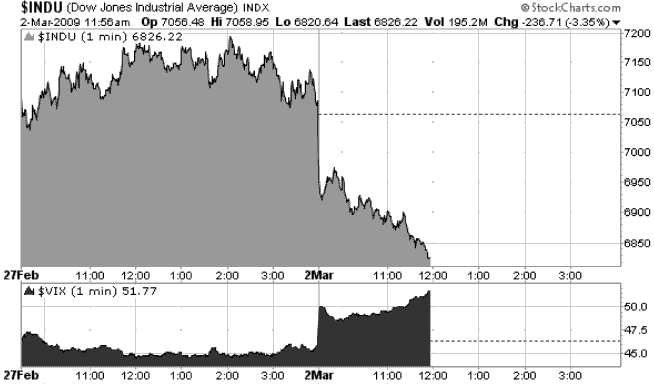Good Morning. MBS is playing follow the leader this morning. TSYs are rallying on a general flight to safety and MBS is steadily pacing the flattening yield curve. TSYs are outperforming the MBS stack...spreads wider. Rate sheets are better for some and worse for others...dont forget about erratic pricing strategies!!!! We have March 4 coming up so some investors may be reluctant to play the market ahead of HEADLINE NEWS. (Also remember Profit Takers dont like Supply)
12pm marks...
FN30_________________________________
FN 4.5 -------->>>> +0-10 to 100-15 from 100-05
FN 5.0 -------->>>> +0-07 to 101-29 from 101-22
FN 5.5 -------->>>> +0-07 to 102-20 from 102-13
FN 6.0 -------->>>> +0-05 to 103-14 from 103-09

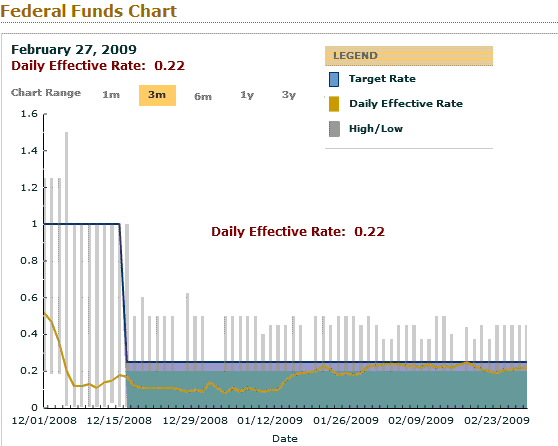
Why the Flight to Safety this Morning?

U.S. Treasury and Federal Reserve Board Announce Participation in AIG Restructuring Plan
The U.S. Treasury Department and the Federal Reserve Board today announced a restructuring of the government's assistance to AIG in order to stabilize this systemically important company in a manner that best protects the US taxpayer. Specifically, the government's restructuring is designed to enhance the company's capital and liquidity in order to facilitate the orderly completion of the company's global divestiture program.
Treasury has stated that public ownership of financial institutions is not a policy goal and, to the extent public ownership is an outcome of Treasury actions, as it has been with AIG, it will work to replace government resources with those from the private sector to create a more focused, restructured and viable economic entity as rapidly as possible. This restructuring is aimed at accelerating this process. Key steps of the restructuring plan include:
The U.S. Treasury will exchange its existing $40 billion cumulative perpetual preferred shares for new preferred shares with revised terms that more closely resemble common equity and thus improve the quality of AIG's equity and its financial leverage.
The Treasury Department will create a new equity capital facility, which allows AIG to draw down up to $30 billion as needed over time in exchange for non-cumulative preferred stock to the U.S. Treasury.
CLICK ME TO READ TREASURY PRESS RELEASE

HSBC Finance Corporation today announced the discontinuation of loan originations of all products by its Consumer Lending business. HSBC will continue to service and collect the existing receivable portfolio as it runs off, while continuing efforts to reach out and assist mortgage customers with their loan repayments and home preservation. The Consumer Lending branch offices, branded in the US as HFC and Beneficial, will cease taking new loan applications as soon as practical and substantially all branch offices will be closed as soon as commitments to customers are satisfied.\
from Bloomberg...
"HSBC said full-year net income fell 70 percent after losses in North America, where it bought Household International Inc., the biggest lender to homeowners with poor credit histories, six years ago. The bank, which gets more than 75 percent of profit from emerging markets, must now cope with recessions in some Asian economies."
"HSBC Holdings Plc plans to raise 12.5 billion pounds ($17.7 billion) in the U.K.'s biggest rights offering as it eliminates 6,100 jobs and closes consumer lending units in the U.S. after subprime losses cut profit."
Full Story: CLICK ME TO READ FULL STORY
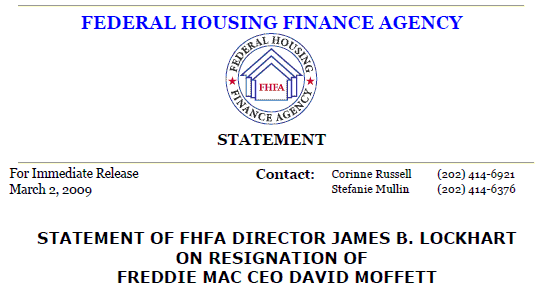
"We thank David Moffett for his service and leadership during the early days of the Conservatorship. FHFA will work with the Freddie Mac Board and management team to ensure a smooth transition and continuation of their important mission of supporting the housing market."
FHFA Press Release: LINK
Freddie Mac Press Release: LINK
Moffett indicated that he wants to return to a role in the financial services sector. In his letter of resignation, he said, "I have enjoyed my time as CEO of Freddie Mac and I wish all the great employees the very best in the days to come."
Freddie Mac management continues to estimate that FHFA, in its capacity as conservator of Freddie Mac, will submit a request to Treasury to draw an additional amount of approximately $30 billion to $35 billion under the Senior Preferred Stock Purchase Agreement between Freddie Mac and Treasury.

According to the Bureau of Economic Analysis...
Personal Savings was much better than expected. The savings rate will eventually lead to more consumer spending...
Press Release: LINK
January Personal income: +$44.8 billion (+0.4 percent) vs. December -$24.0 billion (-0.2 percent). BETTER THAN EXPECTED
January Personal consumption expenditures (Consumer Spending) +$56.4 billion (0.6 percent) vs. December -$101.2 billion (-1.0 percent) BETTER SPENDING THAT THAN EXPECTED (bargain buyers perhaps)
January Personal Savings: $545.5 billion in January compared with $416.8 billion in December. Personal saving as a percentage of disposable personal income was 5.0 percent in January compared with 3.9 percent in December.
Real PCE increased 0.4 percent, in contrast to a decrease of 0.5 percent. Real disposable income increased 1.5 percent in January, compared with an increase of 0.4 percent in December
Goods-producing industries' payrolls decreased $13.0 billion in January, compared with a decrease of $15.3 billion in December; Manufacturing payrolls decreased $9.1 billion, compared with a decrease of $9.2 billion in December. Services-producing industries' payrolls decreased $12.8 billion, compared with a decrease of $11.7 billion in December. Proprietors' income decreased $6.9 billion in January, compared with a decrease of $7.0 billion in December. Nonfarm proprietors' income decreased $7.1 billion, compared with a decrease of $6.4 billion. Rental income of persons decreased $0.4 billion in January, in contrast to an increase of $4.0 percent in December. Personal income receipts on assets (personal interest income plus personal dividend income) decreased $6.7 billion, compared with a decrease of $29.0 billion
Employer contributions for employee pension and insurance funds increased $7.0 billion in January, compared with an increase of $1.7 billion in December. Employer contributions for government social insurance increased $3.1 billion in January, in contrast to a decrease of $1.8 billion in December. Government wage and salary disbursements increased $12.9 billion in January, compared with an increase of $1.4 billion in December. Pay raises for civilian and military personnel added $9.7 billion to government payrolls in January.
Personal current transfer receipts increased $66.6 billion in January, compared with an increase of $29.9 billion in December. The January change in current transfer receipts reflected 5.8-percent cost-of-living adjustments to social security benefits and to several other federal transfer payment programs; together, these changes added $41.1 billion to the January increase
Personal current taxes decreased $138.3 billion in January, compared with a decrease of $6.2 billion in December.
Disposable personal income (DPI) -- personal income less personal current taxes -- increased $183.0 billion, or 1.7 percent, in January, in contrast to a decrease of $17.8 billion, or 0.2 percent, in December.

Construction Spending fell 3.1% in January...more than twice as bad as expected.
YoY Construction Spending has fallen 9.1%. Residential Construction Spending as fallen almost 28% since last January.
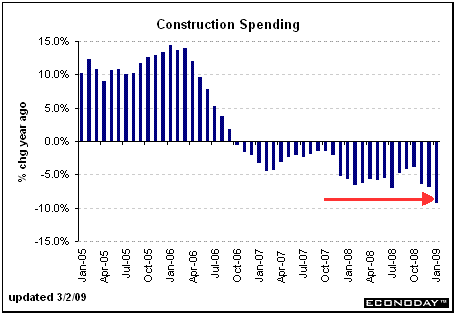
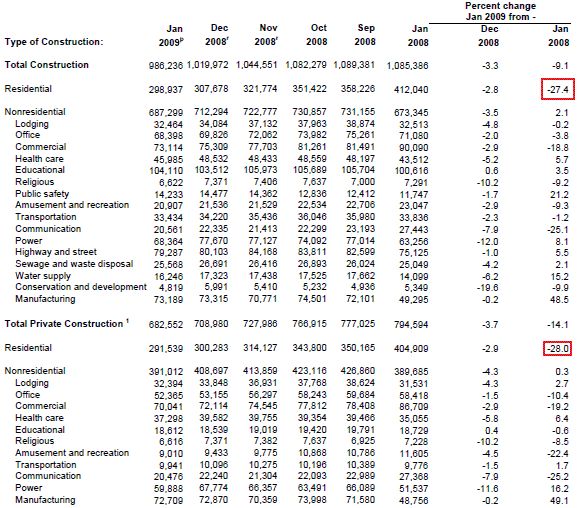
Lastly here is what I would consider the most important economic data of the day....

ISM Manufacturing Index
Press Release: LINK
January: 35.6
Consensus: 33.8
February: 35.8
Better than expected but the current PMI of 35.8 indicates contraction in both the overall economy and the manufacturing sector. A PMI in excess of 41.2 percent, over a period of time, generally indicates an expansion of the overall economy".
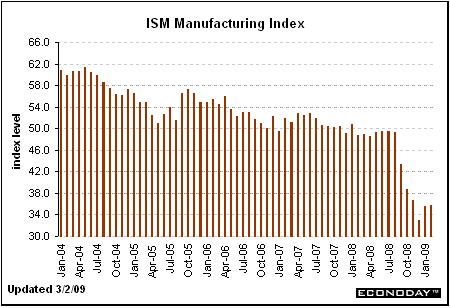
Things have improved since the December record manufacturing low...the labor market's health will continue to weigh on the manufacturing sector so although there are slight positives for now one should not lose sight of the fact that the economy as a whole is still contracting.
"Economic activity in the manufacturing sector failed to grow in February for the 13th consecutive month, and the overall economy contracted for the fifth consecutive month, say the nation's supply executives in the latest Manufacturing ISM Report On Business®."
- "Customers across the board are being very cautious about ordering any stock." (Transportation Equipment)
- "Business is very slow, some of which is due to seasonality, and some is due to the state of the economy." (Chemical Products)
- "Asia previously was over 50 percent of our business and is now close to zero." (Machinery)
- "Still seeing frequent attempts at increases while everything is reacting to an economy that is retracting." (Food, Beverage & Tobacco Products)
- "Business slightly improved in February. May be the result of inventories finally coming into balance with lower demand." (Paper Products)
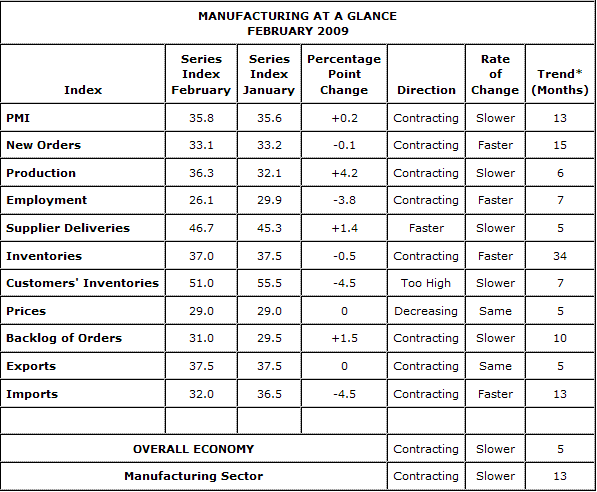
Here's how stocks have reacted to the generally negative news....
